Hundreds of Tibetan activists stage protest in Washington, D.C.
Hundreds of Tibetan activists stage protest in Washington, D.C. |
- Hundreds of Tibetan activists stage protest in Washington, D.C.
- “Digital Dharma” to open Sedona International Film Festival
- Love, passion, and relationships: What your favorite Shambhala Sun contributors have to say
- Unrest grows as China prepares for “war against secessionist sabotage”
- New Buddhist News and Information Website Launches with Free Subscription
- Statesman and exemplary Buddhist leader
- Longmont Buddhist Temple dedicates Japanese scrolls honoring early founders
- New Buddhist retreat opens in Blount County
- Finnish team floored by architectural splendour of Amaravathi
- Russian Buddhist exhibition opened in India
- 7th c. Chinese Buddhist statues in Kitchener
- Destruction of Buddha statues highlight political unrest in Maldives
- Myanmar 'Saffron Revolution' Leader Detained Within Month Of Release
- China must face home truths on Tibet
- Tibetan nun self-immolates: rights groups
- Inside the new Buddhadharma: Feminist trailblazers, a “Cry for Freedom” for Tibet, empowering younger Buddhist teachers; more
- Update: Two Tibetan teens the latest to self-immolate
| Hundreds of Tibetan activists stage protest in Washington, D.C. Posted: 14 Feb 2012 09:00 AM PST While China's next President, Xi Jinping, came to Washington on Monday for a Tuesday visit with President Obama, hundreds of Tibetans and their supporters staged protests in the nation's capital calling for a free Tibet. Adam Tebbe has the story over at Buddhadharma News. Read More @ SourceMatthieu Ricard: Habits of happiness This posting includes an audio/video/photo media file: Download Now |
| “Digital Dharma” to open Sedona International Film Festival Posted: 14 Feb 2012 07:00 AM PST  E. Gene Smith and colleagues in a still from the film When the eighteenth annual Sedona International Film Festival opens next week, the audience will get a sneak peek at Philadelphia director Dafna Yachin's feature-length documentary, Digital Dharma — the documentary film that Buddhadharma News readers recently got to preview. The film tells the story of unlikely hero E. Gene Smith, a Mormon from Utah who, it has been said, saved Tibetan Buddhism.The Digital Dharma 83-minute fine cut will be shown for the first time at the new 750 seat Sedona Cultural Center Theater on Monday, February 20, 2012, at 9:00am. The Sneak Preview will kick off the first full day of the festival. Named the "Fest to Impress" by MovieMaker Magazine, this year's event has been expanded to nine days, running February 18th through the 26th in Sedona. More information is at www.SedonaFilmFestival.com. To view the trailer and to find out more information on the film please visit our website: www.digitaldharma.com. To become a fan of the film on Facebook, please visit: http://www.facebook.com/DigitalDharma. Read More @ SourceCuộc Đời Đức Phật - Thanh Ngân This posting includes an audio/video/photo media file: Download Now |
| Love, passion, and relationships: What your favorite Shambhala Sun contributors have to say Posted: 14 Feb 2012 05:00 AM PST  "Love" calligraphy by Chogyam Trungpa. Happy February 14th to all our readers — including those who won't be acknowledging Valentine's Day. Relationships, after all, can be sources of difficulty as well as joy. But then, as Thich Nhat Hanh tells us, "When you are a full-time buddha, you can find a way to be present and happy in your relationship full-time, no matter what difficulties arise." …Or, even if you're not currently in a relationship at all. Whatever your "status," you'll find guidance and perspective in our special "Love, Passion, and Relationships" Spotlight page, which includes articles by or featuring — in addition to Thich Nhat Hanh — Elizabeth Gilbert, John Welwood, Dzogchen Ponlop Rinpoche, Judith Simmer Brown, and more. Click here to browse it now. Read More @ Source |
| Unrest grows as China prepares for “war against secessionist sabotage” Posted: 13 Feb 2012 11:00 PM PST As the Tibetan New Year approaches amid heightened unrest throughout the region, Chinese Community Party leaders have told officials in the region to recognize "the grave threat in maintaining stability" and to prepare for "a war against secessionist sabotage." The rhetoric follows the fatal shooting deaths of two Tibetan protesters who had been on the run (according to Radio Free Asia) and the firing of seven Chinese officials for "neglect of duty." "Irresponsible officials who walk away from their duties, fail to implement policies or are found guilty of dereliction of duty in maintaining stability shall be immediately removed from their posts, pending punishment, regardless of how great the contributions they made in the past or what kind of position they held," said Chen Quanguo, regional Communist Party chief of Tibet. (Photo by SFT HQ via Flickr, using a CC-BY license.) Read More @ SourceBeautiful Buddhist Music_云水禅心 This posting includes an audio/video/photo media file: Download Now |
| New Buddhist News and Information Website Launches with Free Subscription Posted: 13 Feb 2012 10:00 PM PST The Buddhist Channel, Feb 11, 2012Sacramento, CA (USA) -- A sudden growing interest in Buddhist has accord due to the scientific developments and a dissatisfaction that has come about because of excessive access to consumer good. Air travel has helped people from all over the world to come to the east to study Buddhist with qualified teachers.
Buddha's teachings are about being peaceful, righteous and thoughtful. The Five Precepts of Buddhist are actually the gist of the teachings and a moral guideline that people can follow. Buddhist is said to be a religion, but it is also a science of the mind and a philosophy that has challenged its followers to question even what their teachers say. This growing interest is the reason why Buddhist trends has come into birth.
This is a powerful online information exchange site which wishes to link Buddha Dharma and related subjects for a better understanding of the current Buddhist trends in order to build bridges connecting Buddhists and inspiring Buddhists from all over the world. With the growing interest of Buddha Dharma and the current changes in the world today, Buddhist trends is trying to get the dharma in a way that is accessible to present generation. Buddhist Trends has its aim in providing updated information on latest new, interviews book reviews. Buddhist Trends is a non-profit organization. Buddhist Trends has its heart set creating friendliness in the world by promoting peaceful approach to the way we deal with our problems in the modern world. More information about the services Buddhist Trends offers and the information they share can be found at their website, www.buddhisttrends.com Read More @ SourceMy Artwork: Healing Mandalas This posting includes an audio/video/photo media file: Download Now |
| Statesman and exemplary Buddhist leader Posted: 13 Feb 2012 09:00 PM PST by Rajah Kuruppu, Lanka Daily News, Feb 13, 2012Colombo, Sri Lanka -- The 144th birth anniversary of Sir Baron Jayatilaka, former leader of the State Council and Minister of Home Affairs as well as the first President of the Colombo YMBA falls on February 13.
Born in 1868 in the village of Waragoda in Kelaniya, Sir Baron had his early education at Vidyalankara Pirivena in Peliyagoda where he studied at the feet of the scholar monk, the Ven. Ratmalane Sri Dharmaloka Thera, reputed for his knowledge of Pali, Sanskrit and Buddhist Philosophy. Later, his secondary education was at Wesley College, Colombo, where he had a distinguished career. It is said that on leaving school, Sir Baron sought employment as a clerk in the Department of Lands but the interview board found him too good for the post and observing his potentialities advised him to pursue further studies. Dhamma schools Sir Baron graduated from the University of Calcutta in 1898 and pursued further studies at Jesus College, Oxford in UK, from where he obtained the First Degree in 1913 and the Masters Degree a few years later. Sir Baron was admitted as a Barrister-at-Law of Lincolin's Inn in 1916.
He was very much interested in 'The Buddhist', the English Buddhist journal of the Colombo YMBA, the oldest English Buddhist journal in Sri Lanka and perhaps in the world. Sir Baron was the Editor of this journal for a long period of time and his contribution to sustain and develop it is noteworthy. Sir Baron commenced his career as an educationist and was Principal of Dharmaraja College, Kandy founded by the Buddhist Theosophical Society (BTS) in 1890 and later Principal of Ananda College, Colombo, the premier Buddhist secondary educational institution in the country. He also held the post of General Manager of Buddhist Schools of the BTS. In the temperance movement Sir Baron played an active role. In 1912 he was a member of a delegation that presented the cause of temperance to the Secretary of State for Colonies in London. During the racial riots between the Sinhalese and the Muslims in May 1915, he was arrested and imprisoned for 46 days along with other well-known Buddhist leaders. They were later released in the absence of reliable evidence to connect them with the riots. These events propelled Sir Baron and others as national leaders and earned for them the respect and sympathy of the people. Constitutional reforms Sir Baron was the Secretary of three delegations that made representations to the Secretary of State for Colonies in London advocating constitutional reforms for the country between mid 1919 and 1921. A few years thereafter he took to active politics when he was elected uncontested to represent the Colombo District in the reformed Legislative Council of 1924. In the new State Council of 1931 Sir Baron was returned uncontested for the Kelaniya seat and re-elected unopposed once again in the election of 1936. From 1931 to 1942, he was the leader of the State Council and Minister of Home Affairs. He resigned from Ministerial Office in 1942 to accept an appointment as ambassador for Ceylon in India to expedite the resolution of mutual problems between the two countries. Two years thereafter, Sir Baron was taken seriously ill and passed away on May 31,1942 while on the way to Colombo from New Delhi by air. Thus, came to an end the fruitful life of a great Buddhist leader and a dedicated statesman. A man of impeccable integrity, his sincerity of purpose in his endeavours for Buddhist and the country were acknowledged by both supporters and opponents. Sir Baron was an exemplary Buddhist. He had a profound understanding of the Dhamma and took great efforts to practice the Dhamma in his daily life. The invaluable Buddhist virtues of loving kindness, compassion, joy in the success of others, charity, courage and perseverance were conspicuous features of his character. By meditation and reflection, he developed a mental serenity and tranquility that enabled him to remain calm and unruffled in the hustle and bustle of life and face success and failure with equanimity. Read More @ Source |
| Longmont Buddhist Temple dedicates Japanese scrolls honoring early founders Posted: 13 Feb 2012 08:00 PM PST By Magdalena Wegrzyn, Longmont Times-Call, Feb 10, 2012LONGMONT, CO (USA) -- The Longmont Buddhist Temple's ornate shrine now displays images of two of the faith's most instrumental teachers.
Two hand-painted scrolls, which hang on either side of the shrine, depict two early founders of Jodo Shinshu Buddhism, a non-monastic, household form of Japanese Buddhism the Longmont temple follows. The scrolls, which are each roughly a foot wide and about 2 feet tall, depict two elderly Japanese monks sitting cross-legged in black robes and holding burgundy Buddhist prayer beads. "In some ways, they are a reflection of the teachings these two teachers wanted to share because they are simple and complex at the same time. They are simple in the fact that they're paper and fabric. They're complex in the sense that they represent so much, sort of like the way life works," said the temple's sensei, the Rev. Carol O'Dowd.
One scroll depicts Shinran, a Japanese Buddhist monk who founded the Jodo Shinshu tradition. Shinran, who lived at the turn of the 13th century, worked to make the teachings of Buddha accessible to everyday people. "What he did was he took these really complex teachings and made them simple; anybody could understand them. And then he put them in chant form so they were easy to remember," O'Dowd said. The other scroll shows Rennyo, a descendent of Shinran from the 15th century who is regarded as the "second founder" of the faith, O'Dowd said. In addition to strengthening the organizational structure of the faith, he used printing blocks to write down Shinran's summaries of the sutras, Buddha's teachings. The images of the men face toward the statue of the Amida Buddha, considered by Shin Buddhists to be the embodiment of enlightenment, at the shrine's center. "By having pictures like this, it's a reminder that average people also are part of the enlightenment, and it takes all of us to share wisdom and compassion," O'Dowd said. Longtime Longmont resident Jane Kanemoto donated the scrolls to the temple in honor of her late husband, George, and her brother-in-law, Jimmie, and his wife, Chiyo, who are also deceased. Kanemoto's family helped build the Longmont Buddhist Temple on the northwest corner of Pike Road and U.S. Highway 287. Artisans in Kyoto, Japan, created both scrolls. Kanemoto declined to disclose the scrolls' cost. "I've been wanting to do this for a while, so when (O'Dowd) talks about Shinran, the members would really know what she's talking about," Kanemoto said. Read More @ SourceAntharaya Niwarana Piritha - අන්තරාය නිවාරන පිරිත - This posting includes an audio/video/photo media file: Download Now |
| New Buddhist retreat opens in Blount County Posted: 13 Feb 2012 07:00 PM PST WBIR.com, Feb 12, 2012Blount County, TN (USA) -- Two American Buddhists' journey around the world recently landed them in East Tennessee, after they were charged by their teacher to open a retreat center in Blount County.
"You can plant seeds with prayers and plant seeds with thoughts and aspirations," explained one of the retreat's founders Lama Samten. The retreat is nestled in the hills of Blount County's Happy Valley. The 30 acres of land will one day hold about a dozen private retreat cabins, if all goes according to plan. The cabins will be available for solitary or group retreats, according to Lama Samten. Lama Samten and her husband Lama Karma will teach workshops on meditation and Buddhism to help fund their efforts.
In the meantime, they'll live on the site in the home of University of Tennessee professor and fellow Buddhist, Jeffery Davis. Davis says he plans to dedicate the land to M.O.C.D -- an acronym for the retreat's Tibetan name, Milarepa Osel Cho Dzong. The lamas hope to have the cabins built within five years. They also hope to construct a stupa, which is a traditional Buddhist structure. "Originally it was used as an object to enshrine great teachers and an object of veneration," explains Karma. "It's a focal point so it can draw [Buddhists], it serves as a common center. And for people who are not Buddhist, it still has magnetism." The retreat will be open to people of all religions seeking to engage in contemplation and meditation. Samten explains that one of the basic tenets of Buddhism is the aspiration to stop suffering, which can be achieved in part through introspection. "If we can share that by creating a space for people to explore that, the nature of their minds, that would be the best thing I could have imagined doing with my life,"says Samten. For more information, visit the retreat's website. Read More @ Source |
| Finnish team floored by architectural splendour of Amaravathi Posted: 13 Feb 2012 06:00 PM PST The Hindu, Feb 13, 2012
They enjoy a walk around the Buddhist Maha Chaitya Amaravathi, India -- The sun shore brightly on a warm Sunday afternoon and the five-member Group Study Exchange (GSE) team from Finland set out to Amaravathi, a prominent Buddhist pilgrim centre.
Led by Heikki N. Salumäki, team leader of the GSE team, comprising Minna Kristiina Nieminen, Hanna Elina Hytönen, Ville T Saarelainen and Reetaleena Rissanen, the team set out to explore architectural splendour engraved on the many inscriptions on limestone capturing the many milestones in Buddhist. A guided tour of the Archaeological Survey of India museum was an eye-opener. For the members of the team, it was a journey back to the 3rd century BC as the in-charge curator explained in detail the historical significance of every artefact.
A walk around the Buddhist Maha Chaitya, the most prominent landmark, would be etched in their memory forever, they said. But more was to come. The imposing 140-foot Dhyana Buddha statue overlooking the river Krishna, though still incomplete, had the visitors floored. They took a walk around marvelling at the architectural splendour and the intricate embellishments on the structure. On their way back to Guntur, the GSE team stopped at the boys' hostel run by Annadanam Samajam and supported by Rotary Club of Guntur. The inspiring stories of orphans being cared, nurtured and provided all the support to make it in life filled them with compassion. "This is wonderful since the boys are given a second chance to come up in their lives," exclaimed one of the team members. Rotarians, Nagarjuna, Sagar accompanied the team. Read More @ SourceFINDING HAPPINESS IN LIFE-BY:-VEN AJAHN BRAHM This posting includes an audio/video/photo media file: Download Now |
| Russian Buddhist exhibition opened in India Posted: 13 Feb 2012 05:00 PM PST The Voice of Russia, February 13, 2012New Delhi, India -- An exhibition devoted to the history of Buddhism in Russia has opened in India's capital New Delhi. The exhibition mainly displays photos, both old and present-day, of Buddhist monasteries located in those regions of Russia which are populated mainly by Buddhists – Kalmykia, Buryaia, Tuva, Altai and others. Russia's ambassador to India Alexander Kadakin is hoping that the exhibition will help Indians to learn more about the life of Russian Buddhists. Buddhism in Russia is steeped in rich traditions, and Russian Buddhists have always maintained close contacts with their Indian brothers and sisters in faith. In 1741, a decree of Russian Empress Elizabeth II granted Buddhism the status of official recognition in Russia. At present, there are 1.4 mln Buddhists in Russia. Read More @ Source |
| 7th c. Chinese Buddhist statues in Kitchener Posted: 13 Feb 2012 04:00 PM PST After months of negotiation, THEMUSEUM in downtown Kitchener is honoured to be announcing the North American premiere of a spectacular collection of rock carvings from Chongqing, China. Having only left China once before, these almost fifty stunning sculptures, which are part of a World Heritage Site, will be on display at THEMUSEUM beginning this September. The carvings, originally located in the steep hillsides throughout Dazu County, in Chongqing, China, represent a small percent of what still remains on site. The entire collection is made of a series of Chinese religious sculptures and carvings, dating back as far as the 7th century. The carvings are influenced by and depict images of Buddhist, Confucian and Taoist beliefs. The collection is made up of seventy-five protected sites containing some 50,000 statues, with over 100,000 Chinese characters forming inscriptions and epigraphs. While the majority of them are carved into hillsides, a small number have been excavated for travel. Press release here: http://www.marketwire.com/press-release/north-american-premiere-of-chinese-culture-announced-1617934.htm Museum website here: http://www.themuseum.ca/home.htm Read More @ SourceMyanmar Magic HD This posting includes an audio/video/photo media file: Download Now |
| Destruction of Buddha statues highlight political unrest in Maldives Posted: 13 Feb 2012 03:00 PM PST At the National Museum in Maldives last Tuesday, six men entered the museum and destroy nearly 30 Buddha statues. Maldives, a Sunni Muslim country, was once a Buddhist nation until the 12th century, when it is believed that the country converted to Islam. According to reports, the men destroyed these archaeological treasures because they believe them to be idols, illegal under both Islamic and national law. These acts of vandalism give rise to concern that extremists within the country are gaining ground. The vandalism took place on the same day that democratically elected president Mohamed Nasheed says that he was forced out of office during a coup, though his opponents claim that his resignation was voluntary – this after protests by Islamic and opposition political parties aimed at the president for not "cracking down on massage parlors that operated as brothels" and for his proposal to allow hotels on the island inhabited by Maldivians to serve alcohol. While a few of the statues may be able to be repaired and restored, the majority of them will be a loss; this is particularly frustrating for archaeologists because many of the island's ancient artifacts have either been lost or destroyed over the years. Read More @ SourceTheory of a Deadman Photoshow through Drowing Pool's 'Bringing Me Down' 10-12-11 This posting includes an audio/video/photo media file: Download Now |
| Myanmar 'Saffron Revolution' Leader Detained Within Month Of Release Posted: 13 Feb 2012 02:00 PM PST RTTNews, Feb 12, 2012Yangon, Myanmar -- A high-profile political prisoner released by the Myanmar government last month was taken into custody on Friday, reports said.
Ashin Gambira, leader of the Buddhist monks' alliance that led brutally suppressed anti-government rallies in September 2007, was picked up from a monastery in Yangon in a covert operation after midnight. Reports said he was arrested for interrogation for "breaching regulations." The outspoken dissident, who had reportedly been reopening monasteries closed by the military government after the 2007 "saffron revolution," was taken away because he broke the locks of three monasteries since his release, reports quoting an official who requested anonymity said.
Gambira, 32, has been serving a 68-year jail term for being in the forefront of protests against the military junta sparked by hiked fuel and food prices, when the democratically-elected government released him as part of an amnesty to political prisoners on January 13. Gambira expressed relief in getting freedom, but said the country "still has a long way to go." "Although they are releasing prisoners now, they still have characteristics of the dictatorship," the monk told Democratic Voice of Burma, which is broadcasting in exile in Norway. The West hailed the release of 300 political prisoners as a major step towards democratic reform. Read More @ SourceOm Mani Padme Hum This posting includes an audio/video/photo media file: Download Now |
| China must face home truths on Tibet Posted: 13 Feb 2012 01:00 PM PST by John Lee, The Australian, February 14, 2012Sydney, Australia -- THE self-immolation of an 18-year-old Buddhist nun on Saturday was the 22nd known instance of the act in the past year in the Chinese-governed Tibet autonomous region.
Despite the fact that China's hold over Tibet is officially recognised by all major countries, Beijing remains paranoid that external forces seek to split the western regions of Tibet and Xinjiang, which together comprise one third of modern China by landmass, from the rest of the country. But problems in Tibet will not be resolved by condemning all those concerned with possible human rights abuses as "splittists", as Beijing does routinely. Nor will throwing money at a region appease an indigenous people and culture who believe they are being suppressed.
Beijing's sense of domestic vulnerability is genuine. Figures last year indicated Beijing allocated $ US105 billion ($ 98bn) to fund the People's Armed Police, more than the official budget for the People's Liberation Army. Answerable only to the Chinese Communist Party, a disproportionate and growing share of PAP resources is deployed in and around Tibet and Xinjiang. According to official sources, Beijing spent more than $ US50bn on more than 400 major development projects in Tibet alone over several decades. The government complains that such largesse is rewarded with dissent, ignoring the fact that ethnic Han Chinese encouraged en masse to move into these areas have become the beneficiaries of development in these areas. Even though the living standards of ethnic Tibetans have undoubtedly been raised, discrimination in favour of Han Chinese is still widespread. Few ethnic Tibetans can forgive the reported destruction of an estimated 6000 Buddhist temples and shrines in Tibet since the late 1950s. Indeed, forcibly "regulating" traditional Tibetan culture and religion under the watchful and suspicious auspices of state-sanctioned agencies is unlikely to inure today's Tibetans to the realities of Beijing-centred rule. China's paranoia over any sign of unrest in Tibet also betrays its own forced confidence that the CCP's official version of history can sustainably hold. CCP history insists modern-day China, with its 33 provinces, municipalities and autonomous regions (34 if you include Taiwan), is China's natural historical condition, and has been so for thousands of years. Yet this version conveniently overlooks the fact that the preferred geography of the People's Republic of China was decided only after Mao Zedong's communists came to power in 1949. The new political arrangement had several precedents to choose from. Perhaps predictably, Mao chose the grander option, preferring to recreate the perceived glory of a greater China, which the Qing Dynasty ruled over before it fell in 1911. In doing so, the newly created PRC laid claim to lands inhabited by Monguls, Central Asians and Tibetans. The 1950 invasion of Tibet was the first salvo in regenerating a "Greater China" that the Qing Dynasty had bloodily cobbled together in the 18th and 19th centuries. Once incorporated, the reality that Tibet fell back into autonomy from 1911-1950 was conveniently ignored in official histories. Conquering and re-conquering territories and incorporating these into the official maps of those who triumph is hardly unique to China. But its misuse of history is emerging at a time when its every action is heavily scrutinised abroad, and suppressing minorities within one's country is no longer accepted as evidence of a responsible great power. Unlike past centuries, the covenant between sovereigns and citizens puts obligations on both to play their part in maintaining a just order. For China, its modern habit of tolerance for different cultures within its territories is immature in an authoritarian system tending to see domestic and external conspiracies against its rise in the shadows. Denying the historical truth that China is a conquering power leads Beijing to the counter-productive delusion that it has no need to arrive at a mutually acceptable concord with the Tibetan people under its rule. Revisiting official histories might help inform frustrated Beijing officials why many of the indigenous people of Tibet feel little pride in the modern rise and achievements of the PRC. Putting more military and economic resources into imposing order will not do the trick. Revisiting false histories to better understand the discontent of a conquered people and suppressed culture is the better way ahead for Chinese rule in Tibet, and in its attempts to convince the region and the world that its rise should not be feared. ---------- |
| Tibetan nun self-immolates: rights groups Posted: 13 Feb 2012 12:00 PM PST AFP, Feb 13 2012Beijing, China -- An 18-year-old nun set herself on fire in China's restive southwest and later died, rights groups said Sunday, the latest in a spate of such incidents among ethnic Tibetans protesting Beijing's rule.
This brings to at least 19 the number of people who have set themselves on fire in the past year in Tibetan-inhabited areas in protest over Chinese rule. Rights groups say another three Tibetans self-immolated earlier this month in a remote village of Sichuan. However, local authorities quoted in the official Global Times newspaper have denied that account. The nun from the Mamae nunnery shouted out slogans of protest against the Chinese government before setting herself alight, the rights groups said in statements.
Soldiers and police quickly took her away, still alive, and later sealed off the nunnery, the groups said. Free Tibet also said she was the second nun from Mamae to set herself on fire, following another who died in October last year. A police officer in Aba declined to comment. "I am not clear (about this)," the official, who declined to be named, told AFP. Calls to the local Aba government went unanswered. China has stepped up security in Tibet and areas inhabited by ethnic Tibetans following a series of protests against Chinese rule, some of which have turned violent. Security has also been tightened before March, the anniversary of anti-Chinese protests in 2008 which started in the Tibetan capital Lhasa before spreading to other areas. At least two people were killed last month in clashes between police and locals in Sichuan, which has large populations of ethnic Tibetans, many of whom complain of oppression. Security forces on Thursday shot dead two Tibetan brothers who were on the run after protesting against Chinese rule, according to US-based broadcaster Radio Free Asia. Beijing has accused overseas organisations of seeking independence for Tibet and blamed the Dalai Lama -- Tibet's exiled spiritual leader -- for the unrest. Tibetans have long chafed under China's rule over the vast Tibetan plateau, accusing Beijing of curbing religious freedoms and eroding their culture and language, and these tensions have intensified over the past year. But Beijing insists that Tibetans enjoy religious freedom and have benefited from improved living standards brought by China's economic expansion. Following the violent incidents Chinese Prime Minister Wen Jiabao on Friday pledged religious freedom and cultural protection in Tibet. "We will place more importance on improving the lives of our Tibetan compatriots... and in preserving the freedom of religious belief of Tibetans," he said. Free Tibet called on the international community to do more. "A handful of carefully crafted statements is no longer enough -- now is the time for concerted international action," the group said in the statement. The United States said Friday it would raise concerns about human rights among other issues during a closely watched visit in the coming week by Chinese Vice President Xi Jinping, likely the country's next leader. "It is an area of grave concern for us to witness the increase of tensions in Tibet and Xinjiang," said Danny Russel, US President Barack Obama's top adviser on Asia. The northwest region of Xinjiang is home to another ethnic group, Muslim Uighurs, who have also staged violent protests against Chinese rule. Read More @ Source |
| Posted: 13 Feb 2012 11:00 AM PST
Also in the new Buddhadharma: In our new department, Let's Talk, Lodro Rinzler offers why he thinks empowering younger dharma teachers is "A Necessary Gamble"; David Loy, Joan Sutherland, and Mushim Ikeda talk Buddhism and Politics in the new Buddhadharma forum; Kiera Van Gelder on "My Practice Without Meds"; and much more. Click here to browse the new Buddhadharma. Read More @ Source |
| Update: Two Tibetan teens the latest to self-immolate Posted: 13 Feb 2012 10:00 AM PST The Tibetan self-immolation phenomenon continues with two new casualties. (We had originally reported one of these this morning; this story has been updated.) Over the weekend, word came that an 18-year-old nun by the name Tenzin Choedon is one of the latest Tibetans to self-immolate in protest of Chinese oppression in Tibet. A nun at Mamae nunnery in Ngaba County, the reports state that she shouted in protest of Chinese rule in Tibet and called for the Dalai Lama's return before self-immolating near the nunnery on the evening of February 11. She is the 23rd Tibetan to self-immolate since February 2009. According to Tibet Post International, "Sources revealed that she did not succumb to her injuries immediately and that the Chinese soldiers and police in the vicinity took her towards Barkham. Her whereabouts from then on are unavailable." Voice of America is also reporting that a monk, 19 year-old Tibetan monk Lobsang Gyatso of Ngaba County, has self-immolated Monday, the 24th to do so in protest of Chinese rule in Tibet since 2009. Lobsang, a monk of Kirti monastery, reportedly self-immolated after shouting in protest of Chinese oppression. Eyewitness accounts report that Chinese forces immediately put out his flames and whisked him away; his current whereabouts are unknown. According to Free Tibet, "Locals report that extra security personnel have been deployed to checkpoints around Ngaba Town and that people are being searched." For more on the self immolation phenomenon, read Buddhadharma's past coverage, and don't miss Robert Thurman's commentary on the immolation phenomenon from the new, Spring 2012 Buddhadharma — we've made the entire commentary available online. Read More @ Source |
| You are subscribed to email updates from BuddhaRocks ☸ Buddhist To stop receiving these emails, you may unsubscribe now. | Email delivery powered by Google |
| Google Inc., 20 West Kinzie, Chicago IL USA 60610 | |



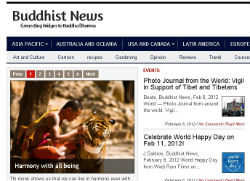 The invasion of Tibet has made many Buddhist masters house hold names in the modern world. The newly launched online information website, Buddhist Trends which spreads the teachings of Lord Buddha and shares information on Buddhist have its aim to use the online media and technology tools to help spread the teaching and support Buddhist communities. Buddhist infomation website, Buddhist Trends also offers free subscription for this readers.
The invasion of Tibet has made many Buddhist masters house hold names in the modern world. The newly launched online information website, Buddhist Trends which spreads the teachings of Lord Buddha and shares information on Buddhist have its aim to use the online media and technology tools to help spread the teaching and support Buddhist communities. Buddhist infomation website, Buddhist Trends also offers free subscription for this readers.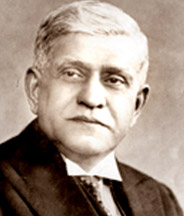 << Sir Baron Jayatilaka
<< Sir Baron Jayatilaka.jpg) << One of two scrolls donated to the Longmont Buddhist Temple recently. The scrolls, which are handcrafted in Japan, are a signature of Jodo-Shinshu temples. Jane Kanemoto, whose family belongs to the temple, donated the scrolls in her late relatives' memory. ( LEWIS GEYER )
<< One of two scrolls donated to the Longmont Buddhist Temple recently. The scrolls, which are handcrafted in Japan, are a signature of Jodo-Shinshu temples. Jane Kanemoto, whose family belongs to the temple, donated the scrolls in her late relatives' memory. ( LEWIS GEYER )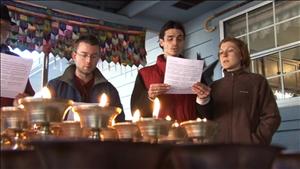 They celebrated the effort with a bulb planting at the site Sunday afternoon.
They celebrated the effort with a bulb planting at the site Sunday afternoon.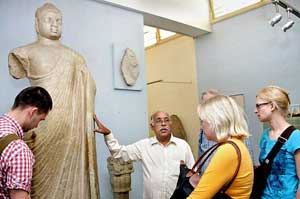 << The Group Study Exchange team Members See Buddhist Art at the ASI Museum in Amaravathi on Sunday.Photo: T.Vijaya Kumar
<< The Group Study Exchange team Members See Buddhist Art at the ASI Museum in Amaravathi on Sunday.Photo: T.Vijaya Kumar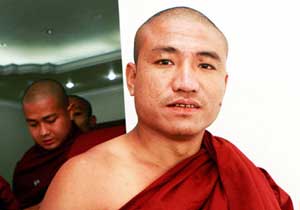 << Shin Gambira, a prominent Buddhist monk in Burma who has been detained by authorities again. Photograph: Khin Maung Win/AP
<< Shin Gambira, a prominent Buddhist monk in Burma who has been detained by authorities again. Photograph: Khin Maung Win/AP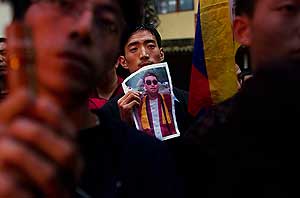 Last week, Beijing pledged to "resolutely crack down" on any ethnic Tibetan protesters while the Chinese Tibetan government warned that any local official failing to perform their duty of maintaining order "will be fired on the spot and subject to disciplinary penalties."
Last week, Beijing pledged to "resolutely crack down" on any ethnic Tibetan protesters while the Chinese Tibetan government warned that any local official failing to perform their duty of maintaining order "will be fired on the spot and subject to disciplinary penalties."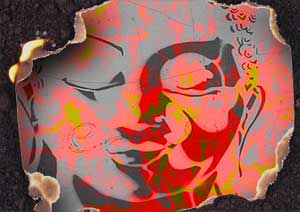 The woman -- a member of a Buddhist nunnery in Aba prefecture in China's Sichuan province, which borders Tibet -- set herself alight on Saturday evening, Free Tibet and the International Campaign for Tibet said.
The woman -- a member of a Buddhist nunnery in Aba prefecture in China's Sichuan province, which borders Tibet -- set herself alight on Saturday evening, Free Tibet and the International Campaign for Tibet said. One helped transform American society, the other is helping to transform the lives of Buddhist nuns. In the new Buddhadharma magazine, feminist trailblazers Gloria Steinem and Jetsunma Tenzin Palmo talk candidly about the personal challenges they've faced, the progress they've seen, and why there's still more to be done. It's in the new, Spring 2012 issue of Buddhadharma and you can sample it
One helped transform American society, the other is helping to transform the lives of Buddhist nuns. In the new Buddhadharma magazine, feminist trailblazers Gloria Steinem and Jetsunma Tenzin Palmo talk candidly about the personal challenges they've faced, the progress they've seen, and why there's still more to be done. It's in the new, Spring 2012 issue of Buddhadharma and you can sample it 